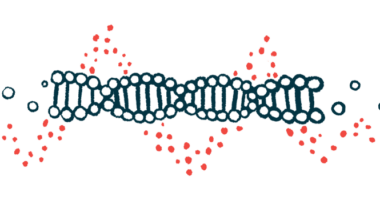Rare FAP Gene Mutation Linked to Poor Prognosis Found in Spain
Endemic mutation tied to neurological, heart, eye problems in new study

Glu89Lys, a rare gene mutation that can cause familial amyloid polyneuropathy (FAP) — and is associated with early onset disease and a mix of cardiac, neurological, and eye problems — was found to be endemic in Spain, a recent study reported.
Researchers conducted a DNA analysis of seven families reaching back nearly 20 generations and “revealed a common origin from an ancestor who lived ∼500 years ago in southeast Spain.”
Patients carrying this mutation have poor outcomes, especially if not treated with disease-modifying therapies, according to the team.
“Median survival from birth was 61.6 years and no individual survived beyond 65 years,” the researchers wrote.
The study, “Phenotype and clinical outcomes of Glu89Lys hereditary transthyretin amyloidosis: a new endemic variant in Spain,” was published in the journal Amyloid.
Searching for an FAP gene mutation
FAP, a form of hereditary transthyretin amyloidosis, is a rare progressive disease caused by genetic mutations mutations in the TTR gene. These mutations lead to the production of a faulty transthyretin protein that clumps together in different tissues and organs. The defective protein especially affects the peripheral nerves — those found outside the brain and spinal cord.
To date, more than 100 TTR disease-causing mutations have been reported. One of them, known as Glu89Lys (p.Glu109Lys), has been found in only 12 cases worldwide.
Two recent reports suggested Glu89Lys may be particularly frequent in Spain, but the clinical course of patients carrying this mutation remained unknown.
Now, researchers in Spain analyzed clinical anonymized data of 13 patients carrying the Glu89Lys mutation and 25 relatives. All apart from one patient were followed at seven centers between 2003 and 2021. Among the patients, the mean age was 50.2 years and 30.8% were women. The mean age of the relatives was 35.2 years, and nearly half (44%) were women.
At initial examination, eight patients (61.5%) showed a mix of cardiac and neurological symptoms, while four (31%) had only cardiomyopathy — a disease of the heart muscle. One patient (8%) had mixed cardiac and neurologic symptoms, along with eye problems.
Of the 25 relatives evaluated, 17 (68%) had no organ involvement at initial examination, while eight (32%) already showed signs of disease that were neurological, heart-related, or a mix of both. Relatives with symptoms were significantly older than those without them — specifically, with a mean age of 45.7 versus 30.3 years).
Heart-related problems appeared at a mean age of 48.4 years, while neurological ones arose a bit earlier, at a mean age of 46.8 years. Additionally, in seven patients (18%), the eyes also were affected, but the onset of symptoms was significantly delayed — at a mean age of 52.8 years — when compared with both cardiac and neurological symptoms.
After a median follow-up of 5.1 years, seven patients required a heart transplant — at a median age of 50.5 years — and seven died. Three patients had sudden death, and one each died of advanced heart failure, neurological progression, cancer, and pneumonia. Overall, the patients had a median life expectancy of 61.6 years, with none living past the age of 65.
Therapies, transplants needed for most patients
A total of 13 patients (48%) with nerve damage or neuropathy were given treatment with tafamidis, a medication sold as Vyndaqel. It is approved in Europe to treat FAP and in the U.S. to treat heart muscle disease in adults with cardiac amyloidosis.
From these, five (38.5%) switched to Onpattro (patisiran), an approved FAP therapy. This was due to neurological progression despite tafamidis treatment for a median period of 13.6 months.
Seven patients underwent a liver transplant within a median of 4.9 years after diagnosis. All of these patients also received a heart transplant.
Two patients (7%) received off-label Dolobid (diflunisal), a nonsteroidal anti-inflammatory medication, and five (18.5%) did not receive any disease-modifying treatment.
Among patients who underwent a heart transplant, those treated with tafamidis or Onpattro showed a significantly better prognosis than untreated patients.
To learn more, researchers next analyzed the geographical distribution of the 14 families included in the study. The majority — 12 families or 86% — were from Andalusia, a region in Southern Spain. More specifically, 10 families (71%) were from the Jaen province.
The place of origin for eight families (57%) was a medium-sized town called Villacarrillo, in the north of the Jaen providence, the researchers noted.
Because of their close geographical proximity, the team hypothesized that a common ancestor could be responsible for the current distribution of the mutation, even centuries later.
Therefore, they analyzed the haplotype, or a set of DNA variations that tend to be inherited together, of seven unrelated participants. This testing revealed that they shared a portion of their DNA.
With this data, the researchers were able to estimate that the most recent common ancestor of these seven families lived about 500 years ago — or 19.7 generations in the past.
Overall, the findings of this study suggest that FAP patients with this variant have established symptoms “by the age of 60, early onset and mixed cardiac and neurologic [symptoms] in the majority of cases, with some patients also experiencing [eye] complications,” the team wrote.
“Patients have poor prognosis, particularly if not treated with disease-modifying therapies,” they added.








